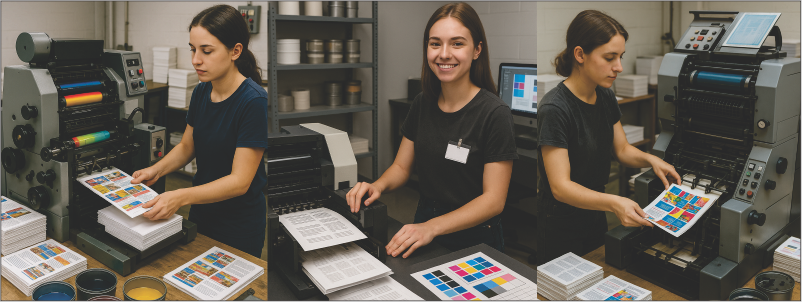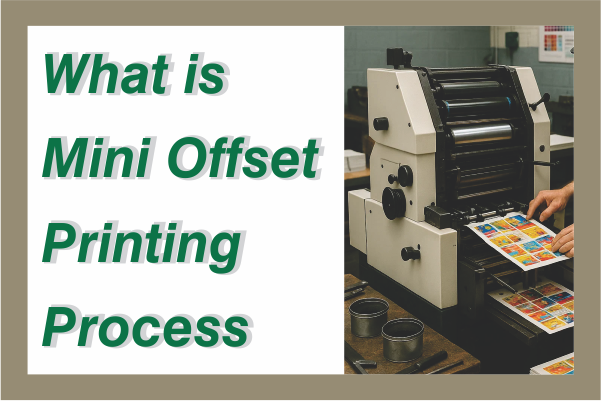The mini offset Printing process is very important in many areas, such as communication, marketing, publishing, and education. While large-scale printing processes like full-size offset and digital printing dominate the commercial space, Mini Offset Printing has carved out its own niche in small to medium printing businesses. This blog explores the Mini Offset Printing Process, its working mechanism, advantages, and how it fits into the evolving landscape of print technology.
What is Offset Printing? A Quick Recap
Before learning about the mini offset printing process, you need know the basics of traditional offset printing. In traditional offset printing, images are transferred from a metal plate to a rubber blanket and then onto the print surface (usually paper). It is known for:
- High-quality output
- Cost-efficiency for large print runs
- Use of CMYK color processing
- Need for detailed setup (plates, ink, water balance)
Now let’s move into the specialized domain of Mini Offset Printing, which is a streamlined version of this process.
Understanding Mini Offset Printing process
Mini Offset Printing process is a compact and economical variation of conventional offset printing, designed for smaller print volumes and simpler operations. These machines are ideal for small businesses, local print shops, and educational institutions.
Key characteristics of mini offset printing process :
- Uses smaller plates and blankets
- Handles sheet sizes like A4, A3, or smaller formats
- Operates with a single color or two-color system
- Manual or semi-automatic paper feeding
Mini offset printing process is the go-to method for short-run jobs like letterheads, bill books, envelopes, flyers, and small posters.
History and Evolution of Mini Offset Machines
Mini offset machines emerged in the mid to late 20th century to cater to local printers and small-scale businesses. As printing technology evolved, the need for a cost-effective alternative to large offset machines became apparent.
Key developments include:
- Manual machines in the 1970s–1980s
- Semi-automatic models in the 1990s
- Compact, motor-driven systems in the 2000s
- Present-day models with digital plate-making compatibility
Components of a Mini Offset Printing Machine
Though smaller in size, mini offset machines maintain the core structure of offset printing:
- Plate Cylinder – Holds the image plate
- Blanket Cylinder – Transfers image to paper
- Impression Cylinder – Applies pressure to transfer ink
- Ink Rollers – Distribute ink evenly to the plate
- Dampening Rollers – Maintain the water layer for lithographic balance
- Feeding System – Manual or semi-automatic paper feed
- Delivery Tray – Collects the printed sheets
Optional add-ons include perforating units and numbering heads.
How the Mini Offset Printing Process Works
The mini offset printing process follows these steps:
- Plate Making: A design is printed on a polyester plate or aluminum plate. In mini offset, plates are often made manually or with a simple thermal CTP system.
- Mounting the Plate: The printing plate is firmly attached to the plate cylinder inside the printing machine.
- Applying Ink and Moisture: A system of rollers sends both ink and a dampening solution to the plate. The image portions attract ink, while the non-image areas resist it because of the water film.
- Image Transfer: The image is transferred from the plate to the blanket and then to the paper.
- Sheet Feeding: The paper is manually or semi-automatically fed into the machine.
- Delivery: The printed sheet exits onto the delivery tray for drying or finishing.
Differences Between Mini Offset and Conventional Offset
| Feature | Mini Offset | Conventional Offset |
| Size | Small, portable | Large and heavy |
| Paper Handling | A4 to A3 sheets | A3 to A0 and larger |
| Print Volume | Low to medium | Medium to high |
| Color Options | 1 or 2-color mostly | 4-color CMYK and beyond |
| Plate Type | Polyester or aluminum | Aluminum (higher quality) |
| Setup Time | Minimal | Time-consuming |
| Cost | Affordable | Expensive setup and operation |
Advantages of Mini Offset Printing process
1. Cost-Effective for Small Runs
No need for massive investment or high-volume printing to break even.
2. Compact Size
Can fit into small spaces—ideal for tight work environments
3. Easy Maintenance
Simple structure and fewer parts mean easier troubleshooting and servicing.
4. Fast Setup Time
Plates are easier to prepare and mount, reducing downtime.
5. Suitable for Common Office Print Jobs
Letterheads, vouchers, bills, forms, and single-page promotional materials.
6. Minimal Power Consumption
Uses less electricity compared to large presses.
Limitations of Mini Offset Printing Process
1. Limited Color Capability
Mostly single or dual-color; full-color printing is difficult or inefficient.
2. Not Suitable for High-Volume Jobs
Designed for small runs—slower and less efficient for thousands of copies.
3. Lower Resolution
Cannot match the photographic quality of high-end offset or digital presses.
4. Manual Operations
Many mini offset machines require manual feeding, which slows down production.
Applications and Use Cases
Mini offset presses are widely used for:
- Office Stationery (letterheads, envelopes)
- Invoices and Bill Books
- Flyers and Leaflets
- Examination Papers
- Election Ballots
- Event Tickets
- Invitations and Greeting Cards
- NGO and Government Departmental Printing
Their affordability and versatility make them a favorite for quick, low-cost print jobs.
Comparison with Digital Printing for Small Jobs
| Aspect | Mini Offset Printing | Digital Printing |
| Setup Cost | Low | Very low |
| Per-Unit Cost | Lower for 200+ copies | Lower for <200 copies |
| Print Quality | Good | Very high |
| Variable Data Printing | Not ideal | Excellent |
| Print Speed | Moderate | Fast |
| Paper Range | Standard | Flexible |
Mini offset wins on cost per unit for slightly higher volumes, while digital printing excels at speed and flexibility.
Maintenance and Troubleshooting of Mini Offset Machines
Regular maintenance ensures longevity:

- Daily Cleaning of rollers and blankets
- Ink and Water Level Management
- Plate Alignment Checks
- Lubrication of mechanical parts
- Roller Pressure Calibration
Common issues include ink smudging, misalignment, and paper jams—all solvable with basic training.
Cost and Setup Considerations
- Machine Cost : Rs. 80,000 to Rs. 3 lakhs approx.
- Plate Cost: 750 approx. per plate (polyester); higher for aluminum
- Running Cost: Very low per print after setup
- ROI: Excellent for local printers or schools needing regular prints
Setup takes 10–20 minutes, making it ideal for walk-in jobs.
Environmental Impact
While not as eco-friendly as digital printing, mini offset can be sustainable:
- Use of recyclable polyester plates
- Soy-based inks as alternatives
- Efficient ink usage and less paper waste
- Avoids harsh chemicals used in traditional offset
Proper disposal of used plates and inks is still crucial.
Mini Offset in the Modern Printing Industry
Even though there are more and more digital printing possibilities, tiny offset is still important because of
- Low startup costs for new entrepreneurs
- Demand for low-cost printed materials in developing regions
- Use in educational institutes, NGOs, and government departments
- Compatibility with low-cost plate-making options (e.g., laser plate making)
Some modern machines now integrate digital controls for enhanced efficiency.
Conclusion
The Mini Offset Printing Process is a practical, cost-effective, and reliable method for small-scale printing needs. While it may not match the sophistication of full-size offset or the speed of digital presses, it offers a unique balance of affordability, quality, and versatility—especially valuable in local, educational, and startup settings.
For students, DTP professionals, or entrepreneurs looking to enter the printing business with limited capital, mini offset is an excellent entry point. It stands as a testament to how traditional printing methods continue to evolve and adapt in a changing digital world.

